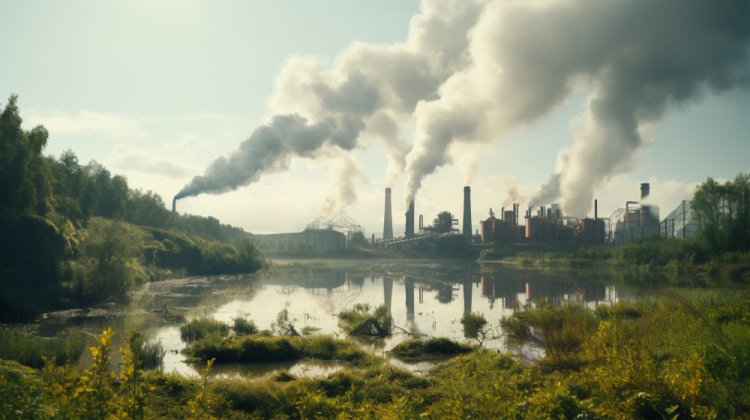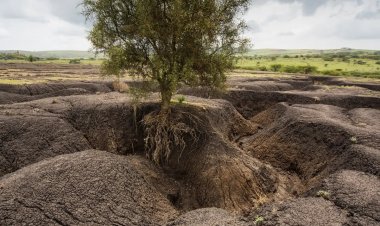India’s Evolving Economy in the Era of Climate Change: A road to development or downfall?
The article will discuss India's current situation and the ways it can mitigate to make us reach closer to the Sustainable Development Goals.

Analysis
By: Srishti Gautam
We stand six years away from the 2030 global agenda. But are we even close to achieving it?
Today, the entire world is negatively impacted by climate change. If we do not curb greenhouse gas emissions and adapt or mitigate climate change, it could have a serious impact on the country’s economy. Rise in sea level and temperature, along with extreme weather conditions will impact property and infrastructure of importance, human health and productivity, and negatively affect key sectors such as agriculture, forestry, fisheries and tourism. The energy demand will increase as power generation becomes less reliable, and water supplies will be stressed and further depleted. The global damage will also affect the demand and supply chain in the international market.
The article will discuss India's current situation and the ways it can mitigate to make us reach closer to the Sustainable Development Goals.
Introduction:
As per the World Economic Forum Global Report 2020, the top 5 risks looming over the next decade are climate-related. These include human-made disasters, climate action failure, natural disasters, biodiversity loss, and extreme weather conditions. While dealing with the effects of climate change, developing economies like India are expected to suffer the most. A recent report by the University of Delaware highlights that India observed an 8% loss in GDP during the year 2022 and a cumulative decline of 7.9% in capital wealth. In the next 30 years, the total loss is estimated to be a staggering $3555 billion. The situation is further worsening, and the United Nations Economic and Social Commission for Asia and the Pacific (UNESCAP) has warned that India may lose 35% of its GDP to Climate Change by 2100.
Sectoral Analysis:
- Agriculture- Agriculture is the backbone of India's economy, contributing 14% to the country's GDP and employing 42% of its population. However, this sector is also the most vulnerable to climate change, threatening the livelihoods of 1.38 billion people who depend on it. The gravity of the situation becomes apparent when we realize the direct impact it has on the lives of such a large number of people.
Erratic rainfall and extreme weather events including global temperature rise, droughts and cyclones have a severe impact on the food, nutrition consumption and farmer livelihood. The government of India conducted a climate change impact assessment that highlighted the reduction of wheat yield by 19.3% in 2050 and 40% in 2080. With the growing population and growing food demand, the decline in agricultural produce would be a major stressor for the years to come. In addition, a staggering decline in the annual freshwater availability and a continuous depletion of groundwater; impacting the overall agricultural productivity and economic risks.
- Energy- The Energy Sector is the largest contributor of greenhouse gas (GHG) emissions, accounting for about two-thirds of total emissions. India is the 4th largest emitter of GHG in the world after China. With coal being the dominant energy source, the emissions are only likely to increase. To mitigate the challenges, India has targeted to achieve 50 percent power from non-fossil-fuel-based energy sources by 2030 and achieve net zero by 2070. Green projects have been initiated across the country under the smart cities mission such as solar rooftop infrastructure, green electricity, and green transportation. But fossil fuel still accounts for 60 percent of the installed capacity.
So where does the gap lie? This is because of the need to meet the growing demand arising from urbanization, expansion of transport infrastructure and industrial production. While every country is aware of the environmental benefits of renewable energy, there remains a dilemma of policy priority between environmental concern and economic growth. At the outset of climatic disruptions, renewable energy seems like an attractive alternative to traditional fossil fuel consumption, however, introducing renewable energy technology, consuming and making them available for the citizens is not only a time-consuming process but a costly one as well. The governments of the developing nations in particular need to make a conscious balance between climate change mitigation and economic growth.
- Tourism- According to the World Travel and Tourism Council (WTTC), travel and tourism contributed 6% to India’s GDP in 2018 and ranked 7th in the world in terms of contribution to the GDP. Being a geographically diverse country, India has multiple offerings for tourists. However, the sector is highly susceptible to extreme weather events, with natural emergencies affecting the infrastructure, increasing maintenance costs and preparedness measures. Moreover, according to another WTTC Report, the tourism sector creates around a tenth of the greenhouse gas emissions. Another report by Yes Bank stated that air travel is responsible for 40% of the total carbon emissions caused by this sector, and 54-75% of radiative forcing. The accommodation sector accounts for 20% of emissions through heating, air-conditioning and the maintenance of accommodation infrastructure. Museums, theme parks, events or shopping also contribute to roughly 3% of emissions.
Mitigation measures and way forward:
As Sustainable Development Goals (SDGs) 13.2 states to ‘integrate climate change measures into national policies, strategies and planning, India has responded through missions and programmes to reduce the country’s risk to climate vulnerability. These are the National Solar Mission (NSM), National Mission for Enhanced Energy Efficiency (NMEEE), National Mission on Sustainable Habitat (NMSH), National Water Mission (NWM), National Mission for Sustaining the Himalayan Ecosystem (NMSHE), National Mission for a Green India (NMGI) and National Mission for Sustainable Agriculture (NMSA).
On August 3, 2022, the Union Cabinet under Prime Minister Narendra Modi passed the revised Nationally Determined Contributions (NDCs) for consideration by the United Nations Framework Convention on Climate Change (UNFCCC) under the Paris Agreement. It states to reach India’s goal of achieving net zero by 2070. Under it, India has streamlined quantifiable and non-quantifiable goals to reach its objective. The quantifiable goals are to reduce the emissions intensity of its GDP by 45 percent by 2030, from the 2005 level, to achieve about 50 per cent cumulative electric power installed capacity from non-fossil fuel-based energy resources by 2030, with the help of the transfer of technology and low-cost international finance including from the Green Climate Fund (GCF) and to create an additional carbon sink of 2.5 to 3 billion tonnes of CO2 equivalent through additional forest and tree cover by 2030. Similarly, the non-quantifiable goals are to propagate a sustainable way of living through a mass movement of ‘LIFE’- Lifestyle for Environment- a key to combating climate change, to increase climate investments in vulnerable sectors, to mobilize domestic and new additional funds from developed countries and build capacities, and to create a domestic framework and international architecture for quick diffusion of cutting-edge climate technology in India.
However, the real challenge for India lies in arranging new investment, which is estimated to be in the range of $7.2 trillion to $12.1 trillion till 2050, according to the RBI. The cumulative total expenditure for adapting to climate change in India is estimated to be `85.6 lakh crore by 2030, according to projections by the Ministry of Environment, Forest and Climate Change. While there is no dearth of capital, there remains higher risks with new technologies like offshore wind, battery storage, green hydrogen, etc. These perceive technology risks and high upfront capital requirements. Therefore, the way forward requires a blended financing mechanism or co-lending facilities. Access to both domestic and international capital is required to meet its energy transition. Moreover, capital infusion in the form of equity and pension funds can be beneficial in providing the much-needed capital. Similarly, Multilateral Development Banks can play a critical role in catalyzing capital through public funds and philanthropic capital in the global south.
Although the announcement of the Loss and Damage fund at COP28 was a significant financial event, with amounts totaling more than US $4720 million, it is still insufficient to meet the needs arising from climate change. Developed countries like the US have not contributed substantially to this cause. The primary focus now should be on providing financial assistance to vulnerable and small nations, as they are the ones most affected by climate change, despite contributing little to the problem. Developing countries like India, in particular, require concessional finance, which remains a challenge since the funds usually come at market rates rather than grants or concessional money. Therefore, to accelerate progress, India needs to explore other domestic and international sources of funding to meet its climate financing needs.
Today, India is known to be a proactive and influential player in the global economy, showcasing a commitment to collaborative, innovative and localized solutions. As mentioned by PM Modi, “India has been at the forefront of supporting action-oriented steps at the global level in response to climate change. We have always held the view that people and the planet are inseparable and that human well-being and Nature are intrinsically linked”. However, it is evident that there is a clear need to move away from a ‘silo’ approach to a more integrated one, which brings together policy making, the evolution of business models and technological advancement and financing for climate action projects. While Governments continue to play a key role in integrating climate change into national strategies and policy developments, the current need is for all stakeholders to come on board, thereby leveraging collective action to carve a sustainable future.
Disclaimer: This paper is the author's individual scholastic contribution and does not necessarily reflect the organization's viewpoint.
Srishti Gautam is a Programme Officer at UN Global Compact Network India, New Delhi. Her area of interest lies in Climate Action and Water and Sanitation. She is currently leading a project in Climate Action in an aspirational district in Maharashtra.























